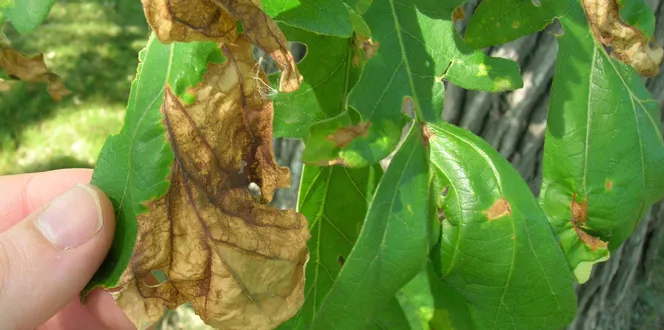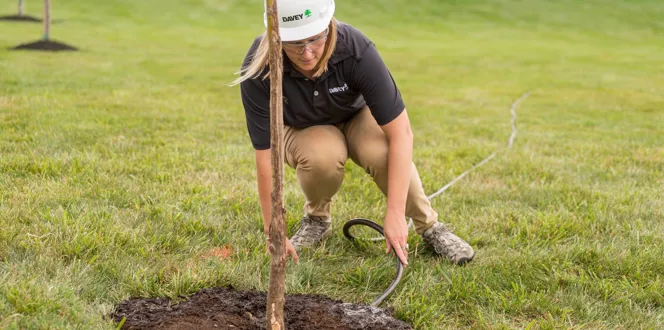We can always tell when something’s a little “off” with our trees.
Take it from Davey blog reader John, for example. He reached out after seeing brown leaves on a couple of bur oak trees in his yard. John said: “My very large oaks have portions where the leaves have turned brown during the summer and fallen off and one had an entire limb that didn't leaf out this summer.”
Oak trees like John’s, and yours, are vulnerable to quite a few pests and diseases that can lead to brown leaves. Below, read about some of the common troubles oak trees face, and learn how to tell what’s what.
Is This Oak Wilt? Reasons Why Oak Leaves Turn Brown
The key to diagnosing your browning oak tree is looking past the color and checking the tree for other symptoms.
Causes of Tree Leaves Turning Brown
Let’s run down a few of the reasons why your oak tree leaves might be brown.
- Oak wilt is the most concerning item on the list, so let’s knock it out first. Oak wilt is a dangerous and deadly fungus that blocks the flow of water inside of trees, causing leaf browning, premature leaf drop, and tree decline.
- Anthracnose is a scary-sounding yet fairly harmless leaf disease that causes blotchy brown spots on leaves and makes leaves crinkle or curl up.
- Bur oak blight is a disease that invades (you guessed it) bur oak trees and makes leaves turn brown and fall off in late summer.
- Drought stress can make leaves wilt and turn yellow or brown. Here are some other symptoms of drought stress.
- Borer insects, like the two-lined chestnut borer, make leaves turn brown, wilt and eventually fall off.
- Root rot causes browning, starting at the top of the tree.
Know The Signs And Symptoms Of Oak Wilt Disease
Because oak wilt disease is a serious threat to oak trees, it’s important to know the distinguishing factors that set it apart from other tree problems. Unfortunately, red oaks plagued by oak wilt will quickly decline and eventually die, but spotting the symptoms is the best way to protect other trees in your yard.
There are three telling signs of oak wilt disease:
- In mid-summer, browning occurs first on the edges of leaves and then closes in, leaving just the base of the leaf green. Also, the leaves wilt or look water-soaked.
- Leaves droop or fall off early, so it’s common to see a bed of brownish-green leaves as well as fully green leaves in your tree bed during summer or early fall.
- While not visible, gray and black mats of fungus develop right under the outer layer of bark (mostly on red oak trees, but not as often on white oaks). Sometimes the fungus breaks through, so you’ll see cracks in the tree’s bark and get a whiff of a fruity scent.
What Does Oak Wilt Look Like?
Infected red oak leaves consist of discoloration, wilt, and defoliation. Live oaks show browning of the veins followed by leaf discoloration and defoliation. Below are oak wilt images for identification.

Is My Tree Experiencing Oak Wilt Disease, Or Is It Something Else?
Any problem with your oak tree calls for an arborist’s attention, but you should certainly contact an arborist ASAP if you have a hunch that your tree’s infected with oak wilt.
Even if oak wilt doesn’t appear to be the culprit, it’s much better to be safe than sorry. As the list above proves, many oak tree problems look awfully alike. The best thing you can do for your tree is to get a professional opinion.





